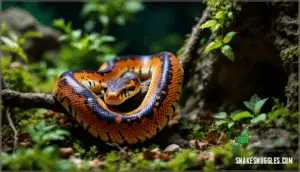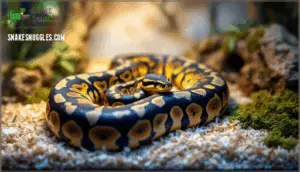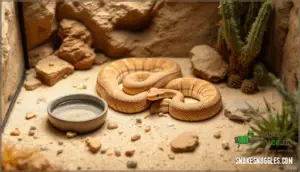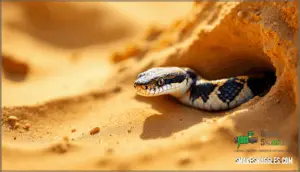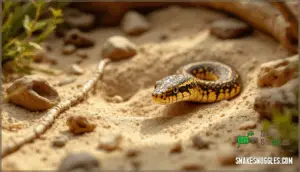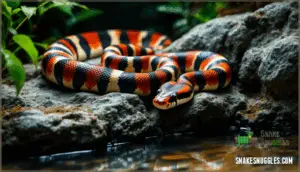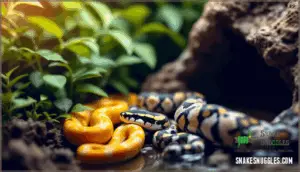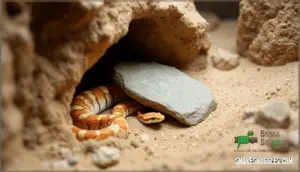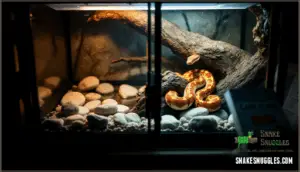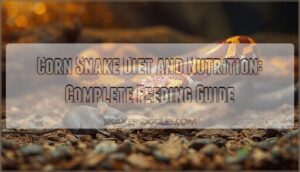This site is supported by our readers. We may earn a commission, at no cost to you, if you purchase through links.
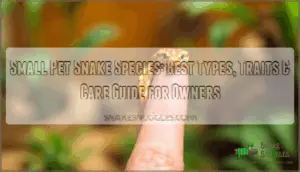
Small pet snake species bring both science class curiosity and living-room calm into your daily rhythm. They ask for so little, yet offer a front-row seat to patient, fascinating actions that reward careful attention.
Take a closer look, and these slender escape artists reveal traits that set them apart from more predictable pets.
Table Of Contents
Key Takeaways
- Small pet snakes like corn snakes, ball pythons, and rosy boas offer manageable size, gentle temperaments, and long lifespans (10–30 years), making them ideal for beginners who want low-maintenance companions.
- Proper enclosure setup requires attention to temperature gradients, humidity control, hiding spots, and ventilation—each species has specific needs that directly affect your snake’s health and behavior.
- Feeding frozen-thawed prey sized to match your snake’s body width, combined with regular enclosure cleaning and monitoring for health signs like appetite changes or breathing issues, prevents common problems and keeps your pet thriving.
- Building trust through gentle, brief handling and teaching proper safety practices protects both you and your snake, while captive-bred snakes from reputable sources ensure healthier pets and legal, ethical ownership.
Key Traits of Small Pet Snake Species
Small pet snakes stand out for their manageable size, gentle temperaments, and unique color patterns. Each species brings its own charm and care needs to the table.
Here’s what sets these popular options apart.
Size and Lifespan
Every small snake species brings unique size and lifespan surprises to your care journey. Adult Length and Weight Ranges offer variety—from the petite 14-inch Western Hognose to sizable ball pythons. Gender Differences can shape snake size, while pet snake lifespans span a decade or more. Ball pythons use their heat-sensing pores to detect thermal images of prey.
Benefits of small snakes include:
- Manageable enclosures
- Long-term companionship
- Minimal upkeep
- Striking variety
- Adaptable to small spaces
Temperament and Handling
When you’re ready to move from admiring a snake’s markings to actually holding one, temperament suddenly matters just as much as size or lifespan. Docile snakes accept gentle interaction with little aggression, which lowers bite risk and makes them child-safe.
Frequent, calm interaction helps tame nervous individuals—consistency turns anxiety into trust, making snake temperament and interaction a breeze for most species.
Non-Venomous Nature
Feeling comfortable when you reach into a snake’s enclosure often comes down to knowing your pet is non-venomous and safe to touch. This makes a huge difference for beginners and families alike.
Nonvenomous snakes offer:
- Less Bite Risk and higher confidence when picking them up
- Venom absence means safer pets and easy snake restraint
- A beginner friendly step into responsible reptile care
Appearance and Color Variations
While peace of mind is important, it’s the remarkable range of colors and patterns that often captures your attention the moment you meet a small pet snake.
From vibrant albino snakes and striking color morphs to subtle regional variations and bold snake markings, each species reveals its own signature pattern morph, scale texture, and color intensity, making snake identification genuinely fascinating.
Best Small Snake Species for Beginners
Choosing your first pet snake can feel overwhelming with so many species out there. To make things easier, we’ve narrowed it down to a handful of beginner-friendly options.
Here’s what you should know about some of the best small snakes for new owners.
Corn Snakes
Curious about a classic beginner snake? Corn snakes check every box: they’re manageable in size, with most adults topping out at 3–4 feet, and thriving in moderate enclosure sizes. Lifespans reach 10–15 years, plus over 80 color morphs give you lots of choices. They’re popular due to their docile nature.
You’ll appreciate their:
- gentle temperament and ease of holding
- simple snake enclosure requirements
- easy feeding habits for snake care
Ball Pythons
Ball pythons occupy a special spot among beginner snake choices, thanks to their impressive lifespan potential—some live up to thirty years. You get bold morph variations and a gentle temperament that eases interaction concerns.
Their feeding habits are predictable, and a young ball python settles nicely into a 20-gallon snake enclosure. Just remember, temperament concerns lessen with regular, gentle interaction.
Rosy Boas
Among small snake species, the Rosy Boa stands out for a gentle temperament and impressive captivity lifespan—often topping twenty years. Natural morphs show off soft stripes, adding beauty to a manageable pet.
You’ll only need a 10- to 15-gallon enclosure size. Just watch humidity levels, since these small pets prefer drier air to thrive in your care.
Kenyan Sand Boas
Looking for a snake that loves to burrow and stays small? The Kenyan Sand Boa, with roots in Northern Africa, wins fans with its docile temperament and fascinating burrowing habits. You’ll appreciate how easy they’re to house—think 10-gallon tanks.
Here’s what stands out:
- Compact enclosure size
- Docile temperament
- Burrowing habits
- Easy feeding habits
- Desert origin
Western Hognose Snakes
Ever wonder what small snake shakes up beginner collections with personality? The Western Hognose stands out: you’ll spot its upturned snout and gentle temperament right away. They’re famed for dramatic defensive actions—think bluffing, not biting—and come in diverse hognose morphs. Focus on habitat enrichment and regular interaction. Beginners value their nonvenomous constriction and rare feeding problems.
| Trait | Details | Why It Matters |
|---|---|---|
| Defensive Behavior | Bluff, hiss, rarely bite | Safe and interesting for beginners |
| Morph Variety | Numerous color/pattern morphs | Customizable appearance |
| Conservation Status | Generally stable | Ethical pet choice |
| Feeding Issues | Rare, generally eat readily | Low-maintenance feeding |
Milk Snakes
Why choose a Milk Snake? For many, it’s the hypnotic mix of bold bands and the sheer diversity of Milk Snake morphs. With calm, easy-to-hold personalities and impressive regional variations, this small snake adapts well through captive breeding.
Their manageable size, hardy nature, and secure conservation status make the Milk Snake an approachable, beginner pet snake that thrives in thoughtfully designed habitats.
Choosing The Right Small Pet Snake
Choosing a small pet snake starts with understanding what each species needs to feel at home. Before you make a decision, it’s important to think about space, personality, availability, and how much care you’re ready to give.
Here’s what you should consider as you look through your options.
Assessing Space and Enclosure Needs
Before you bring a small snake home, take a moment to picture where it’ll live—and just how much space you’ll really need for a healthy, active pet. The right enclosure size matters, but so does setting up a proper snake habitat.
Consider these essentials for any snake enclosure setup:
- Room for movement and climbing
- Reliable temperature gradient
- Layers of safe substrate choice
- Multiple hiding spots for comfort
- Habitat enrichment like branches and decor
Considering Temperament and Handling Ease
Once you’ve planned out your snake’s living space, it’s worth thinking about which snake will actually enjoy your company—and how easy it’ll be to manage from day one. Docile species, like Corn Snakes or Rosy Boas, tend to thrive with regular interaction.
Prioritizing beginner-friendly snakes and temperament factors means smoother, safer interaction and less stress for both you and your pet.
Availability and Captive-Bred Options
Regarding snake species availability, captive-bred snakes are everywhere now—providing reassurance and vigorous health for owners. With booming market growth, breeders focus on:
- Captive breeding for legal compliance
- Diverse snake breeds and morphs
- Reliable owner satisfaction rates
- Enhanced genetic diversity
- Marketplace transparency (CB labeling)
That wide selection makes finding your ideal snake easier than ever.
Commitment to Long-Term Care
While picking out your favorite from the wide world of captive-bred snakes is exciting, it’s wise to remember that bringing one home means you’re signing up for years of steady, thoughtful care. Even minor lifestyle changes or unexpected challenges, from financial burden to future planning, shape your snake’s health and maintenance needs.
Bringing home a small pet snake means committing to years of steady care, as lifestyle changes and unforeseen challenges will shape your ability to meet its ongoing health and maintenance needs
| Reptile Ownership Responsibilities | Snake Care Requirements |
|---|---|
| Financial burden, caregiver options | Ongoing snake maintenance |
| Commitment to snake health | Adapting to lifestyle changes |
| Future planning | Addressing unexpected challenges |
Care Requirements for Small Pet Snakes
Caring for a small pet snake means getting a few key details right. Every species has its own needs regarding comfort, food, and safety.
Let’s look at what you’ll need to create the right setup at home.
Enclosure Setup and Habitat Design
Imagine you’re setting up a tiny wilderness where your snake can explore, rest, and feel right at home. Ventilation needs are a must; always pick enclosures designed for airflow. Add the right substrate choices for burrowing or hiding. Arrange hiding spots, some climbing decor for exercise, and a water source. With thoughtful snake habitat setup, you’ll meet basic snake enclosure requirements with ease.
Temperature, Humidity, and Lighting Needs
Whether you’re raising a desert-dweller or a forest native, dialing in the right temperature, humidity, and light will make all the difference for your snake’s comfort. Here’s what matters most:
- Heating gradients for thermoregulation.
- Humidity control based on species.
- Lighting cycles to mimic wild conditions.
- Basking spots and UVB lamp for seasonal adjustments.
Feeding Habits and Diet
When you watch your snake size up its next meal, you’ll realize feeding is about much more than just dropping food in a bowl. Prey size should always match your snake’s body width, and feeding frequency depends on age and species.
See the table below for practical snake feeding tips:
| Tip | Details |
|---|---|
| Prey Size | As wide as the snake’s midsection |
| Feeding Frequency | Juveniles: every 5–7 days; adults: 7–14 days |
| Frozen vs. Live | Frozen-thawed is safer than live prey |
| Dietary Variety | Occasional variety aids nutrition |
| Supplementation | Rarely required if feeding complete prey |
Enclosure Maintenance and Hygiene
Keeping your snake’s home clean is just as important as providing the right food or temperature—think of cleanliness as the foundation for your pet’s health and comfort. Remove waste promptly, choose substrates that make spot cleaning easy, and use safe disinfection protocols.
Changing water daily, preventing mold, and checking the enclosure regularly help your snake thrive.
Health, Safety, and Handling Tips
Keeping your snake healthy and safe is easier when you learn a few practical habits. Interacting, housing, and spotting trouble all matter more than you might think.
Here’s what you’ll want to know as you set things up.
Safe Handling Techniques
Interacting with your pet snake safely is all about building trust, moving slow, and paying attention to the little things your snake tells you. Always give proper support along the body, keep interactions brief, and watch for stress signals.
Stick to good hygiene practices, especially after interacting, and teach child safety from day one—these snake safety tips really matter for everyone’s well-being.
Preventing Escape and Injuries
If you’ve ever wondered how a determined little snake can squeeze through the tiniest gap, you’re not alone—securing every inch of their enclosure is just the start when it comes to keeping your curious pet safe.
Use tight latch closures, double-check all openings, and supervise young kids. Careful snake care and safe transport cut down on injury risks and escape drama.
Common Health Issues and Prevention
No enclosure is escape-proof without a healthy, thriving snake inside. Still, even with your best effort, common health issues like Respiratory Infections or Parasitic Infestations can sneak in.
Stay on top of snake health and maintenance with these habits:
- Monitor for Mouth Rot or Fungal Disorders
- Prioritize nutrition over treats
- Clean often
- Quarantine newcomers
- Support proper shedding and growth
Signs of Stress or Illness
Even when you keep up with regular care, your snake will give you a few hints when it isn’t feeling right. Appetite changes, shedding problems, abnormal scales, or labored breathing can signal an issue with snake health and wellness. Listless conduct, unusual movement, or excessive hiding often mean something’s off. Stay alert—early action is key for snake health care.
| Snake Signal | What to Watch For | What it May Mean |
|---|---|---|
| Appetite changes | Skipped meals | Stress, snake diseases |
| Abnormal scales | Weird color or texture | Skin, health issues |
| Breathing issues | Wheezing, open-mouth | Respiratory concern |
Frequently Asked Questions (FAQs)
Can small pet snakes coexist with other pets?
Predator-prey dynamics, species compatibility, and hygiene concerns shape safe coexistence. Supervised interactions and safe separation between pet snakes and other pets are essential.
Understanding snake safety, actions, and responsible reptile ownership protects all animals—never gamble with unsupervised encounters.
What enrichment activities do small snakes enjoy?
Small snakes thrive with climbing opportunities, sensory stimulation, and novel objects in their habitat. Burrowing patterns and hunting simulation with puzzle feeders add richness to their environment, encouraging natural snake actions and supporting healthy snake care.
Plenty of hiding places further enhance their living space, promoting a sense of security and well-being.
How often do small snakes shed their skin?
Your snake’s skin renewal happens gradually throughout its life. Most hatchlings shed every 5–7 days during rapid growth, while adults usually shed every 4–8 weeks. Shedding frequency depends on age, growth rate, and environmental factors.
Proper humidity and temperature support healthy shedding cycles. Watch for cloudy eyes and dull coloring—these signal an upcoming shed. Provide rough surfaces and maintain moisture to aid the process naturally.
Are small snakes suitable for allergy sufferers?
Yes, small pet snakes are excellent for allergy sufferers. Unlike mammals, reptiles don’t produce dander or shed fur, making them hypoallergenic. You won’t encounter snake allergens from their skin or coat.
Proper snake care and regular enclosure cleaning further minimize any potential allergic reactions, making for safer pet ownership for those with reptile allergies.
What travel options exist for small snake owners?
Traveling with pet snakes requires careful planning. For car travel, maintain proper temperature control and secure enclosures. Airline regulations usually prohibit reptiles in cabins; check with carriers before booking.
Shipping snakes involves specialized pet transport services and travel stress considerations. Boarding facilities specific to reptiles offer safer alternatives than general pet care. Research options thoroughly before any journey.
Conclusion
Small pet snake species are like living sculptures—beautiful, low-maintenance companions that reward your patience with endless fascination. Whether you choose a corn snake’s vibrant patterns or a sand boa’s burrowing grace, these reptiles thrive on consistency and respect.
Your commitment to proper enclosure setup, feeding schedules, and careful interaction transforms you from a keeper into a true herpetologist. Start small, stay observant, and you’ll discover why small pet snakes captivate enthusiasts worldwide.
- https://a-z-animals.com/animals/snake/snake-facts/pet-snakes-that-stay-small/
- https://onurbicycle.wordpress.com/2020/05/07/smallest-pet-snakes/
- https://www.zillarules.com/articles/types-of-pet-snakes
- https://www.merckvetmanual.com/multimedia/table/average-life-span-of-reptiles-in-captivity
- https://pethelpful.com/reptiles-amphibians/the-smallest-pet-snakes-for-beginners-with-easy-care

